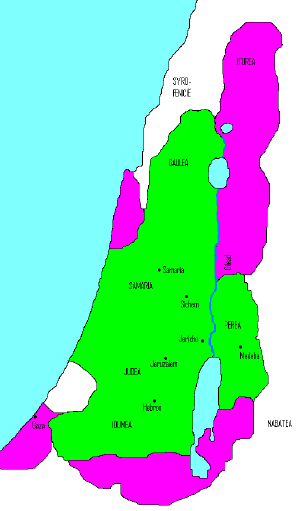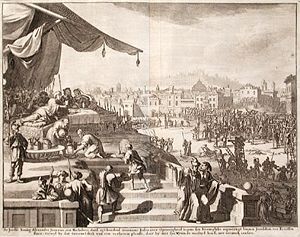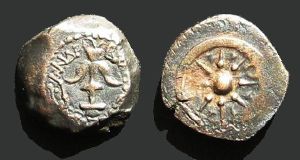Alexander Jannaeus
Alexander Jannaeus (also known as Alexander Jannai/Yannai), king of Judea from (103 B.C.E. to 76 B.C.E.), son of John Hyrcanus, inherited the throne from his brother Aristobulus, and appears to have married his brother's widow, Shlomtzion or "Shelomit," also known as Salome Alexandra, according to the Biblical law of Yibum ("levirate marriage"), although Josephus is inexplicit on that point.
His likely full Hebrew name was Jonathan; he may have been the High Priest Jonathan, rather than his great-uncle of the same name, who established the Masada fortress. Under the name King Yannai, he appears as a wicked tyrant in the Talmud, reflecting his conflict with the Pharisee party. He is among the more colorful historical figures, despite being little known outside specialized history. He and his widow (who became queen regnant after his death) had substantial impact on the subsequent development of Judaism and Christianity.[1]
Civil war against the Pharisees
An avid supporter of the aristocratic priestly faction known as the Sadducees, his reign was constantly challenged by opponents, among them a brother with a rival claim to the throne, and the populist urban-based Pharisee party.
At the beginning of his reign Alexander Jannaeus halted the suppression of the Pharisees and the Sages for a while, under the influence of his wife Salome Alexandra (said to be the sister of the great Jewish sage Shimon ben Shetach). This gave him time and resources to increase his power and prestige by extending the territory under his rule through war and conquest. As his power grew, however, he enlisted foreign soldiers to suppress his own people and eliminate the Pharisees.
One year during the Jewish holiday of Sukkot, Alexander Jannaeus, while officiating as the High Priest (Kohen Gadol) at the Temple in Jerusalem, demonstrated his support of the Sadducees by denying the law of the water libation. The crowd responded with shock at his mockery and showed their displeasure by pelting Alexander with the etrogim (citrons) that they were holding in their hands. Unwittingly, the crowd had played right into Alexander's hands. He had intended to incite the people to riot and his soldiers fell upon the crowd at his command. The soldiers slew more than 6,000 people in the Temple courtyard.
A civil war started, in which the Pharisees allied with the Seleucid king Demetrius III against Alexander Jannaeus. He first retreated, but then managed to oust his rivals thanks to popular support against the Seleucid invasion of Judea. During the civil war, Alexander Jannaeus suppressed his rivals brutally, killing his brother and many leading Pharisees. The New Century Book of Facts writes:
- "It is said that 50,000 perished in this civil strife. He quelled a revolt at Jerusalem by slaughtering 6,000. On his return from a short exile into which he had been driven by the Pharisees, he caused 800 rebels to be crucified before him and their wives and children slaughtered (86 B.C.E.)."
The crucifixion of 800 leading Pharisees was suggested by Alexander's retainer, the Greek soldier Diogenes of Judea. After Alexander's death his widow Alexandra Salome, at the urging of her brother Simeon ben Shetach, had Diogenes put to death.
Alliance with the Essenes
Alexander Jannaeus may have been in close relation with the monastic Essenes at some point, who were probably allies during his fight against the Pharisees. A piece from the Dead Sea scrolls from Qumran appears to be an homage to him:
- "holy city/ for king Jonathan/ and all the congregation of your people/ Israel/ who are in the four/ winds of heaven/ peace be (for) all/ and upon your kingdom/ your name be blessed" (Transcription and translation by E. Eshel, H. Eshel, and A. Yardeni)
Alexander Jannaeus showed considerable competence as a military leader, repelling invaders and expanding the country's borders to the west and south. He was defeated by Ptolemy Lathyrus in Galilee; made an alliance with Cleopatra and drove Ptolemy out. By the end of his rule, the borders of his state would exceed that of David and extend to Gaza and far into Jordan.
Upon his death, he was succeeded as monarch by his wife Salome Alexandra, known also and better as Shlomzion, and succeeded as High Priest by his son John Hyrcanus II.
Coinage
The coinage of Alexander Jannaeus is characteristic of the early Jewish coinage in that it avoided human or animal representations, in opposition to the surrounding Greek, and later Roman types of the period. Jewish coinage instead focused on symbols, either natural, such as the palm tree, the pomegranate or the star, either man-made, such as the Temple, the Menorah, trumpets or cornucopia.
Alexander Jannaeus was the first of the Jewish kings to introduce the "eight-ray star" or "eight-spoked wheel" symbol, in his bronze "Widow's mite" coins, in combination with the wide-spread Seleucid numismatic symbol of the anchor. These coins are thought to be the ones referred to in the Bible in Luke 21:1-4:
- "and Jesus sat over against the treasury, and beheld how the people cast money into the treasury; and many that were rich cast in much. And He called unto him His disciples, and saith unto them, Verily I say unto you, that this poor widow hath cast more in, than all they which have cast into the treasury: For all they did cast in of their abundance; but she of her want did cast in all that she had"
Depending on the make, the star symbol can be shown with straight spokes connected to the outside circle, in a style rather indicative of a wheel. On others, the spokes can have a more "flame-like" shape, more indicative of the representation of a star within a diadem.
It is not clear what the wheel or star may exactly symbolize, and interpretations vary, from the morning star, to the sun or the heavens. The influence of some Persian symbols of a star within a diadem, or the eight-spoked Buddhist wheel (see the coins of the Indo-Greek king Menander I with this symbol) have also been suggested. The eight-spoked Macedonian star (a variation of which is the Vergina Sun), emblem of the royal Argead dynasty and the ancient kingdom of Macedonia, within a Hellenistic diadem symbolizing royalty (many of the coins depict a small knot with two ends on top of the diadem), seem to be the most probable source for this symbol.
In literature
Alexander Jannaeus is the main character of the novel The King of Flesh and Blood, by Israeli novelist Moshe Shamir.
| House of Asamoneus Died: 76 B.C.E. | ||
|---|---|---|
| Preceded by: Aristobulus I |
King of Judaea 103 B.C.E. – 76 B.C.E. |
Succeeded by: Salome Alexandra |
| High Priest of Judaea 103 B.C.E. – 76 B.C.E. |
Succeeded by: Hyrcanus II | |
Notes
- ↑ Mason, Charles Peter. (1867). "Alexander, Jannaeus". Dictionary of Greek and Roman Biography and Mythology 1: 117. Ed. William Smith. Boston: Little, Brown and Company.
ReferencesISBN links support NWE through referral fees
- "Jewish symbols on ancient Jewish coins" Paul Romanoff, New York American Israel Numismatic Association, 1971.
- This article incorporates some content from the public domain 1911 edition of The New Century Book of Facts published by the King-Richardson Company, Springfield, Massachusetts. (This reference gives a death date of 78 B.C.E., but consensus seems to be 76 B.C.E.)
External links
- Christian Jewelry with Coins of Alexander Yannai (Alexander Jannaeus)
- Leptons and Prutahs of Alexander Jannaeus
- Coinage of King Alexander Jannaeus, "Widow's Mites".
- Coins of King Alexander Jannaeus
- Miniature 'shield' showing the 8-spoked star of the Argead
Credits
New World Encyclopedia writers and editors rewrote and completed the Wikipedia article in accordance with New World Encyclopedia standards. This article abides by terms of the Creative Commons CC-by-sa 3.0 License (CC-by-sa), which may be used and disseminated with proper attribution. Credit is due under the terms of this license that can reference both the New World Encyclopedia contributors and the selfless volunteer contributors of the Wikimedia Foundation. To cite this article click here for a list of acceptable citing formats.The history of earlier contributions by wikipedians is accessible to researchers here:
The history of this article since it was imported to New World Encyclopedia:
Note: Some restrictions may apply to use of individual images which are separately licensed.


